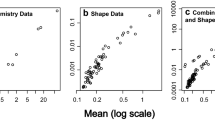Abstract
The field of fisheries research commonly uses classical statistical classification methods to estimate the proportion of fish that return to natal spawning grounds to spawn. With the advent of otolith microchemical analysis, researchers are able to extract information from fish ear stones (otoliths) about the chemical composition of water in which fish have spent distinct periods of their lives. Here we present a method of analysis set in the Bayesian statistical paradigm which enables explicit incorporation of habitat information into the analysis. The ecological system is seen as arising from a mixture of disparate fish populations and information from the biological relationships inherent in otolith formation is exploited through the hierarchical model structure. We present the model and motivation, demonstrate the validity of the model through simulation studies, and conclude with an analysis of a data set from Lake Erie.
Similar content being viewed by others
References
Ashford J, Arkhipkin A, Jones C (2007) Otolith chemistry reflects frontal systems in the Antarctic Circumpolar Current. Mar Ecol Prog Ser 351: 249–260
Ashford J, Jones C, Hoffmann E, Everson I, Moreno C, Duhamel G, Williams R (2008) Otolith chemistry indicates population structuring by the Antarctic Circumpolar Current. Can J Fish Aquat Sci 65: 135–146
Bath G, Thorrold S, Jones C, Campana S, McLaren J, Lam J (2000) Strontium and barium uptake in aragonitic otoliths of marine fish. Geochimica et Cosmochimica Acta 64(10): 1705–1714
Bigrigg JL (2008) Determining stream origin of four purported walleye stocks in Lake Erie using otolith elemental analysis. Master’s thesis, The Ohio State University
Diebolt J, Robert CP (1994) Estimation of finite mixture distributions through Bayesian sampling. J R Stat Soc Ser B 56(2): 363–375
Fablet R, Daverat F, Pontual H (2007) Unsupervised Bayesian reconstruction of individual life histories from otolith signatures: case study of Sr:Ca transects of European eel (Anguilla anguilla) otoliths. Can J Fish Aquat Sci 64: 152–165
Farrell J, Campana SE (1996) Regulation of calcium and strontium deposition on the otoliths of juvenile tilapia, Oreochromis niloticus. Comp Biochem Physiol A: Physiol 115(2): 103–109
Gelman A, Carlin JB, Stern HS, Rubin DB (2004) Bayesian data analysis, 2nd edn. Chapman and Hall, CRC, USA
Kennedy B, Folt C, Blum J, Chamberlain C (1997) Natural isotope markers in salmon. Nature 387: 766–767
Limburg K (2001) Through the gauntlet again: demographic restructuring of american shad by migration. Ecology 82(6): 1584–1596
McLachlan G, Peel D (2000) Finite mixture models. Wiley, New York
Munch S, Clarke L (2008) A Bayesian approach to identifying mixtures from otolith chemistry data. Can J Fish Aquat Sci 65: 2742–2751
Richardson S, Green P (1997) On Bayesian analysis of mixtures with an unknown number of components. J R Stat Soc Ser B 59(4): 731–792
Secor, DH, Dean, JM, Campana, SE (eds) (1995) Recent developments in fish otolith research. University of South Carolina Press, South Carolina
Stephens M (1997) Bayesian methods for mixtures of normal distributions. Ph.D. thesis, Magdalen College, Oxford University
Thorrold S, Jones C, Campana S, McLaren J, Lam J (1998) Trace element signatures in otoliths record natal river of juvenile American shad (Alosa sapidissima). Limnol Oceanogr 43(8): 1826–1835
Walther B, Thorrold S (2006) Water, not food, contributes the majority of strontium and barium deosited in the otoliths of a marine fish. Mar Ecol Prog Ser 311: 125–130
Walther B, Thorrold S, Olney J (2008) Geochemical signatures in otoliths record natal origins of american shad. Trans Am Fish Soc 137: 57–69
White J, Ruttenberg B (2007) Discriminant function analysis in marine ecology: some oversights and their solutions. Mar Ecol Prog Ser 329: 301–305
Zimmerman C, Edwards G, Perry K (2009) Maternal origin and migratory history of steelhead and rainbow trout captured in rivers of the Central Valley, California. Trans Am Fish Soc 138: 280–291
Author information
Authors and Affiliations
Corresponding author
Electronic Supplementary Material
The Below is the Electronic Supplementary Material.
Rights and permissions
About this article
Cite this article
Pflugeisen, B.M., Calder, C.A. Bayesian hierarchical mixture models for otolith microchemistry analysis. Environ Ecol Stat 20, 179–190 (2013). https://doi.org/10.1007/s10651-012-0214-3
Received:
Revised:
Published:
Issue Date:
DOI: https://doi.org/10.1007/s10651-012-0214-3




